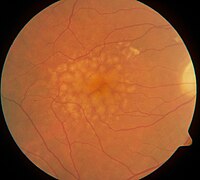
Photo from wikipedia
ABSTRACT Optic disc drusen (ODD) are a well-recognised cause of an elevated optic disc appearance. When visible with ophthalmoscopy and fundus photography, ODD are readily identified. Yet, in more subtle… Click to show full abstract
ABSTRACT Optic disc drusen (ODD) are a well-recognised cause of an elevated optic disc appearance. When visible with ophthalmoscopy and fundus photography, ODD are readily identified. Yet, in more subtle cases of ODD, ancillary testing may be needed to render the diagnosis. Facilitating the diagnosis of ODD has clinical relevance, because affected individuals may otherwise undergo unnecessary costly and invasive investigations to rule out raised intracranial pressure and other causes of optic disc oedema. In this review, the role of established and emerging optical coherence tomography (OCT) techniques in the diagnosis and management of ODD cases is reviewed. A practical approach is taken to explain how to optimise use of commercially available OCT technology in the clinical setting. Optical coherence tomography provides many advantages over other imaging modalities in the diagnosis of ODD, including the ability to correlate retinal measures of neuroaxonal structure with drusen characteristics. Earlier spectral domain OCT techniques, however, were hindered by poor penetrance. In the modern imaging era, enhanced depth imaging OCT and swept source OCT enable higher resolution of ODD and other optic nerve head structures that might otherwise be mistaken for drusen. Ongoing studies featuring OCT angiography indicate that this technique may provide complementary information about microvascular supply that correlate with structural measures of optic nerve injury. Advances in OCT will continue to improve diagnostic accuracy and inform clinical understanding regarding structure-function correlations germane to the longitudinal follow up of ODD patients.
Journal Title: Neuro-Ophthalmology
Year Published: 2021
Link to full text (if available)
Share on Social Media: Sign Up to like & get
recommendations!